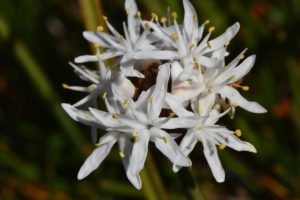
Borya scirpoidea
Basic Information Common Name: Borya scirpoidea Scientific Name: Borya scirpoidea Native Habitat: Southwestern Australia History / Discovery / Cultivator Borya scirpoidea, a member of the
Common Name: Borya
Scientific Name: Borya
Native Habitat: Australia (primarily Western Australia)
The genus Borya belongs to the Boryaceae family, a small family endemic to Australia. The plants are named after Jean Baptiste Bory de Saint-Vincent, a French naturalist, zoologist, and botanist who lived from 1778 to 1846. While Bory de Saint-Vincent did not directly discover or cultivate Borya, the genus was named in his honor, recognizing his significant contributions to the field of natural history and botany. The naming of the genus Borya falls in line with the established botanical tradition of honoring prominent scientists and explorers.
Borya species are relatively obscure in the broader horticultural world, mainly due to their specialized habitat requirements and their slow growth rates. They are primarily found in Western Australia, growing in harsh, rocky environments on hillsides and in lateritic soils. These environments are often subject to extreme temperature fluctuations and seasonal droughts. While not widely cultivated, Borya species are of interest to specialist plant collectors and botanists due to their unique adaptations to these challenging conditions.
The lack of extensive cultivation also means that there isn’t a clear history of specific individuals or nurseries that have significantly popularized Borya. Their niche appeal contributes to their relative obscurity in mainstream gardening. Despite this, ongoing research continues to uncover more about the unique physiology and ecology of these fascinating Australian endemics. Their survival in such difficult habitats underscores the remarkable adaptive capabilities of plants. Further studies on these adaptations could have broader implications for understanding plant resilience in the face of climate change and other environmental challenges. Borya serves as a reminder of the rich biodiversity found in Australia and the need to conserve these unique and often overlooked species. Their understated beauty and ecological importance warrant further exploration and potential conservation efforts.
| Category | General Requirement | Notes |
|---|---|---|
| Light | Full sun | Requires bright, direct sunlight for optimal growth. |
| Water | Infrequent | Allow soil to dry out completely between waterings; drought-tolerant. |
| Humidity | Low | Tolerant of low humidity levels. |
| Temp. Range | Warm | Prefers warm temperatures; avoid freezing conditions. |
| Soil Type | Well-draining | Needs well-draining soil to prevent root rot; sandy or rocky mix suitable. |
| Fertilizer | Minimal | Light feeding during the growing season only. |
| Toxicity | No information available | Insufficient data to determine toxicity to pets or humans. |
Borya species exhibit several adaptations that allow them to survive in the harsh Australian environment. These adaptations include their ability to tolerate prolonged periods of drought, their preference for well-draining soils (preventing waterlogging), and their tolerance of full sun exposure. Some species are known to be fire-tolerant, regenerating after bushfires. The plant’s structure also facilitates water conservation. The plant has the ability to enter dormancy during extended dry periods, ceasing growth until more favorable conditions return.
Given the limited availability and slow growth of Borya species, propagation can be challenging. Seed propagation is possible, but seeds may require specific pre-treatment to encourage germination. Division of established plants can also be attempted, although this is best done with mature specimens and requires careful handling to minimize root disturbance. Stem cuttings may be successful, but rooting can be slow and require specific environmental conditions, such as high humidity and warmth. Air layering is not commonly reported for Borya, but might be viable with specific species and careful monitoring. Grafting, while uncommon, could be considered for specific instances.
There is a significant lack of publicly available, reliable information on the toxicology of Borya species. Therefore, it is advisable to exercise caution when handling the plant and to prevent ingestion by humans or pets. As a general precaution, it is recommended to keep Borya plants out of reach of children and pets, and to wash hands thoroughly after handling the plant. If ingestion is suspected, consult a medical professional or veterinarian immediately.
Borya species are considered relatively rare outside of their native Australian habitat due to a combination of factors. These factors include their slow growth rate, the difficulty in replicating their natural growing conditions, and the limited availability of seeds and propagating material. Additionally, their highly specific habitat requirements limit their appeal to general horticulture, making them more sought after by specialist collectors.
The value of a Borya specimen depends on several factors. Larger, more mature plants typically command higher prices. The overall health and vigor of the plant are also critical determinants of its market value. Plants with unique characteristics, such as unusual growth forms or exceptional flowering displays, may also be more valuable. Current collector trends and the overall demand for rare and unusual plants also play a significant role in shaping the market value of Borya. The rarity of the plant itself drives up the value due to its limited availability.

Basic Information Common Name: Borya scirpoidea Scientific Name: Borya scirpoidea Native Habitat: Southwestern Australia History / Discovery / Cultivator Borya scirpoidea, a member of the

Basic Information Common Name: Borya septentrionalis Scientific Name: Borya septentrionalis Native Habitat: Southwest Australia History / Discovery / Cultivator Borya septentrionalis, commonly known as the
